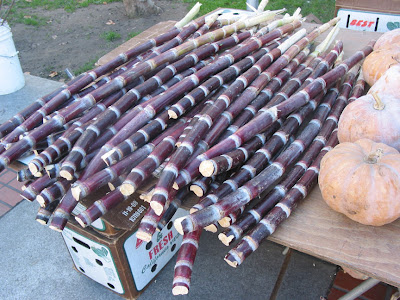
During Mexican Christmas celebrations colorful star shaped piñatas were traditionally filled with citrus fruit, peanuts, small jicamas, sections of sugar cane and colacion, or small pastel colored anise candies. Once the piñatas were smashed open they smell was intoxicating, even if the fruit was a little bruised.
This juicy, crunchy, sweet salad contains some of the same ingredients, and it reminds me of all the smells, colors and tastes of the season. Ensalada de Nochebuena is traditionally served the evening of December the 24th, but you can make it all winter long. To make this salad you'll need the following ingredients:
- One head of lettuce
- Two oranges, peeled and cut in sections
- Once large jicama, shredded (or two small ones)
- 4 ribs of celery, sliced finely
- One cup of fresh pineapple, chopped
- Two medium sized beets, cooked and chopped finely
- One cup of shredded carrots
- One stick of raw sugar cane, peeled and chopped in small pieces *(See notes about eating sugar cane at the end of the recipe)
Garnishes:
- About half a cup of toasted peanuts, or more to taste
- Cut radish "flowers"
- Seeds from one large pomegranate
- 1/4 cup of the water where you boiled the beets
- 1/4 cup of white vinegar
- 1/4 cup of orange, lime or pineapple juice
- 3 tablespoons of sugar
Chop, shred and chill all the ingredients. I use an electric food processor, it cuts things evenly and in less time than chopping manually. Line a large salad bowl with shredded lettuce, arrange the rest of the ingredients on top. I arranged mine in "wedges" like on the photo. Clock wise: Jicama, carrots, pineapple, orange, celery, beets and sugar cane.

Garnish the salad with the peanuts, pomegranate seeds and radishes. Aditionally you can also add anise seeds, and crushed colacion candy. Toss right before you are ready to eat. To make the dressing, combine all the ingredients in a cruet and chill well. Serve the dressing on the side, or the salad will get soggy.
*Notes about eating sugar cane:

* How to eat? Raw sugar cane is very juicy and sweet, but it is also very fiberous. It is perfectly fine to chew out all the juicy goodness and spit out the woody, fiberous part. If you are having a fancy affair and you don't want to see your guests spitting, just omit the sugar cane from your salad. Supervise children when eating raw sugar cane. Don't cut into pieces that are too big, they could be dangerous if not chewed properly.
Where to buy? You can buy raw sugar cane at the farmer's market. It looks like a long stak of bamboo (see the picture above). You'll need to peel it and cut it down to smaller pieces. Here is a link for instructions for peeling and eating a raw sugar cane stick. Even better, you can also buy the cane already in sections, with the tough husks removed, at some Asian and Latino food markets. The come conveniently sealed in little plastic baggies.
Felices Fiestas!


















































